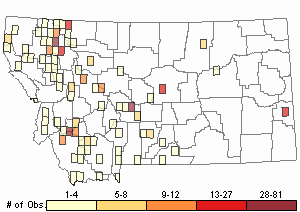View in other NatureServe Network Field Guides
NatureServe
Montana
Utah
Wyoming
Idaho
Wisconsin
British Columbia
South Carolina
Yukon
California
New York
Robust Fountain Moss - Fontinalis antipyretica
Other Names:
Fontinalis antipyretica var. oregonensis
General Description
Plants: Pleurocarpous, to 40 cm in length (FNA 2014), occasionally to 70 cm, often appearing “long and stringy” (Flowers 1973), shiny, red with golden tones (FNA 2014), olive green (Flowers 1973), deep green to green with golden tones, or brown (FNA 2014), the bottom part black (Flowers 1973). Stems irregularly branched (FNA 2014), the lower part of the stem becoming somewhat bare (Flowers 1973); tips of the stems and branches soft, swollen, narrowing to a point; central strand wanting; axillary hairs consisting of 6-10 cells, the first cell square and red (FNA 2014).
Leaves: Those of branches and stems alike, distant to closely-spaced (Crum and Anderson et al. 1981), overlapping or flat against the stem when dry, upright or spreading a little when damp, in 3 vertical rows along the stem (FNA 2014) with those below more remote and spreading, those above more crowded, upright and overlapping (Flowers 1973), strongly folded longitudinally, curving from base to tip along the keel, 2-8 mm in length, egg-shaped, sometimes tending to oblong, seldom approaching circular, tapering to the acute to nearly obtuse and sometimes curved apex; base extending down the stem; leaf edges sometimes bent back and downward widely below on one side (FNA 2014) or sometimes both sides (Flowers 1973); costa absent or scarcely developed (FNA 2014).
Leaf Cells: Medical cells of the lamina long and slender, tapering at the ends, to long and narrowly diamond-shaped; alar cells oblong, swollen, the walls flaccid (FNA 2014).
Range Comments
North American Range
Canada: YT, BC to AB, ON to NL and NS; USA: AK, states west of (to the coast) and including MT to NM, also SD, MN, WI and IL, MI, OH, e and ne to the coast (FNA 2014). Known in Montana from Carbon, Cascade, Flathead, Gallatin, Glacier, Lake, Lincoln, Mineral, Missoula, Ravalli, and Sanders Counties (Elliott and Pipp 2016).
Observations in Montana Natural Heritage Program Database
Number of Observations: 451
(Click on the following maps and charts to see full sized version)
Map Help and Descriptions
Relative Density

Recency



 (Observations spanning multiple months or years are excluded from time charts)
(Observations spanning multiple months or years are excluded from time charts)
Habitat
Affixed to stones, small dead branches, tree and shrub roots and submerged in running water (Crum and Anderson et al. 1981), also pools, swamps, flat area that flood; occurring from lowlands to about 10,826 feet elevation (FNA 2014).
Reproductive Characteristics
Dioicous. Perigonia bud-like, the bracts about 1.3 mm. Perichaetial bracts to 3 mm with a broadly-angled apex. Seta short, 0.2-0.3 mm tall. Capsule 2-2.7 mm in length, hidden amongst the bracts to barely exposed, without stomata; operculum cone-shaped (FNA 2014); exostome teeth somewhat brown (Flowers 1973), 16, slender and frequently joined at the distal ends in pairs; endostome forming a trellis, the segments joined by crosswise bars throughout (perfect). Calyptra cone-shaped and shielding the upper end of the capsule, hairless (FNA 2014).
Stewardship Responsibility
References
- Literature Cited AboveLegend:
 View Online Publication
View Online Publication Crum, H.A. and L.E. Anderson. 1981. Mosses of Eastern North America. 2 volumes. Columbia University Press, New York. 1328 pp.
Crum, H.A. and L.E. Anderson. 1981. Mosses of Eastern North America. 2 volumes. Columbia University Press, New York. 1328 pp. Elliott, J.C. and A.K. Pipp. 2018. A Checklist of Montana Mosses (1880-2018). Updated 3 January, 2020. Montana Natural Heritage Program, Helena, Montana. 73 pp.
Elliott, J.C. and A.K. Pipp. 2018. A Checklist of Montana Mosses (1880-2018). Updated 3 January, 2020. Montana Natural Heritage Program, Helena, Montana. 73 pp. Flora of North America Editorial Committee, eds. 2014. Flora of North America North of Mexico. Volume 28. Bryophytes: Mosses, Part 2. Oxford University Press, Inc., NY. xxi + 702 pp.
Flora of North America Editorial Committee, eds. 2014. Flora of North America North of Mexico. Volume 28. Bryophytes: Mosses, Part 2. Oxford University Press, Inc., NY. xxi + 702 pp. Flowers, S. 1973. Mosses: Utah and the West. Brigham Young University, Provo, Utah. 567 p.
Flowers, S. 1973. Mosses: Utah and the West. Brigham Young University, Provo, Utah. 567 p. Lawton, E. 1971. Moss Flora of the Pacific Northwest. Hattori Botanical Laboratory. Japan: Yamabuki-cho, Shinjuku-ku, Tokyo. 362 pages plus appendices.
Lawton, E. 1971. Moss Flora of the Pacific Northwest. Hattori Botanical Laboratory. Japan: Yamabuki-cho, Shinjuku-ku, Tokyo. 362 pages plus appendices.
- Additional ReferencesLegend:
 View Online Publication
View Online Publication
Do you know of a citation we're missing? Elliot, J. C. 1993. Second checklist of Montana mosses. Unpublished report. U.S. Forest Service, Region 1. Missoula, MT. 45 pp.
Elliot, J. C. 1993. Second checklist of Montana mosses. Unpublished report. U.S. Forest Service, Region 1. Missoula, MT. 45 pp. Lawton, E. 1971. Keys for the Identification of the Mosses on the Pacific Northwest. Reprinted from 'Moss Flora of the Pacific Northwest'. Published as Supplement No. 2 of the Journal of the Hattori Botanical Laboratory. Nichinan, Miyazaki, Japan. 66 pp.
Lawton, E. 1971. Keys for the Identification of the Mosses on the Pacific Northwest. Reprinted from 'Moss Flora of the Pacific Northwest'. Published as Supplement No. 2 of the Journal of the Hattori Botanical Laboratory. Nichinan, Miyazaki, Japan. 66 pp. Malcolm, B., N. Malcolm, J. Shevock, and D. Norris. 2009. California Mosses. Nelson, New Zealand: Micro-Optics Press. 430 pp.
Malcolm, B., N. Malcolm, J. Shevock, and D. Norris. 2009. California Mosses. Nelson, New Zealand: Micro-Optics Press. 430 pp. Rasmussen, S.M. 1968. Composition and structure of macrophyte vegetation of the Firehole River, Yellowstone National Park as related to physical and chemical factors. M.Sc. Thesis. Bozeman, MT: Montana State University. 44 p.
Rasmussen, S.M. 1968. Composition and structure of macrophyte vegetation of the Firehole River, Yellowstone National Park as related to physical and chemical factors. M.Sc. Thesis. Bozeman, MT: Montana State University. 44 p. Smith, A.J.E. 1980. The Moss Flora of Britain and Ireland. Cambridge University Press, Cambridge. 705 pp.
Smith, A.J.E. 1980. The Moss Flora of Britain and Ireland. Cambridge University Press, Cambridge. 705 pp.
- Web Search Engines for Articles on "Robust Fountain Moss"





